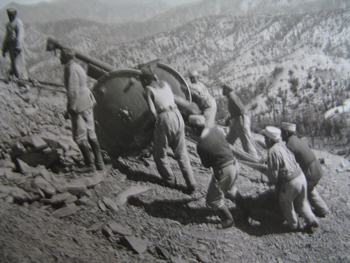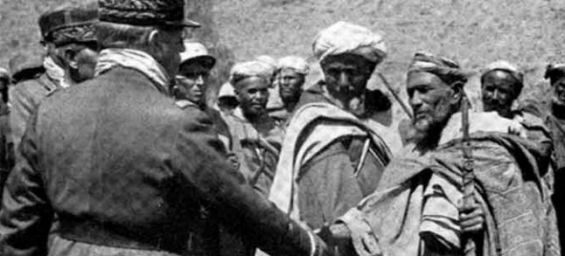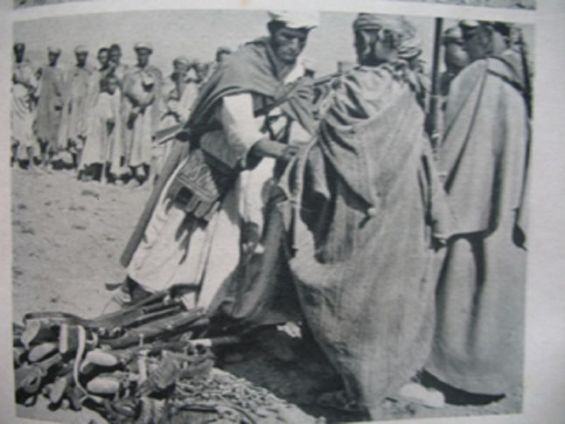Morocco celebrates every year December the 29th, the annual anniversary of Jbel Baddou battles that were fought in 1933 in the southern side of the High-Atlas, most precisely in the region of Errachidia. Although the main battles took place in August and mid-September, the High Commissioner for resistance veterans and members of the liberation army chose the end of Decemebr to «preserve the national memory» and introduce these battles to «younger generations».
Jbel Baddou was a battle field for a series of battles. In his article entitled «La France au Maroc» (The French in Morocco, 1917) ; the French historian Augustin Bernad recalls that the French forces and since they entered the Kingdom, were unable to invade the region of Tafilalt inhabited by Amazigh tribes. They had, indeed, bravely resisted the occupier since the beginning of the twentieth century.
«Several battalions from different commands» against Moroccans who used «derisory means»
Long before that date, several battles had been fought by these tribes, including that of Boudnib in 1908, then the one of Ifri in 1914, as well as others in Tafilalt, Taza, Guelmima and Tadighoust. Right before the battle of Ijeb Baddou, the French colonial forces and the resistant tribes of Ait Skhman clashed in the period between 20th of August and 10th of September, 1932. The violent confrontation in Tazizaout had seen «great loss of life and blood», said Zamane.

To describe Jbel Baddou, Michael Peyron, a French historian who closely studied the Amazigh language and culture, shed light in his research «Les hauts lieux de la résistance amazighe» (2012), (Amazigh resistance in the Atlas), on the place that hosted «the ultimate episode of the epic Atlas resistance». A «steep and isolated high mountain (2 921), emerging from a single impetus above Asoul in Ghéris», was an important strategic location, said the historian.
In his account, he also revisited the violent confrontations experienced by «several battalions under various commands» who used sophisticated weapons. On the other hand, the Moroccan warriors were utulizing «derisory means that they buried in caves relying first and foremost on their courage and bravery». This region was indeed hosting several important and strong Amazigh tribes such as Ait Yahya, Ait Mrghad, Ait Hdiddou and Ait Skhmane.
After the recovery of Jbel Tazizaout, encircled for more than a month by the French, the warriors of Ait Mrghad, Ait Hdiddou, Ait Issa and Assif Melloul, backed by the courageous fighters of Ait Atta, left for Jbel Baddou. A perfect location «riddled with caves and rock bars», offering themselves a natural «defensive wall».
50 days of fierce resistance
After several days of resistance, the French General Antoine Jules Joseph Hure charged Colonel Arnaud of besieging the Amazigh fighters depriving the inhabitants from vital commodities. Eayed Ouhmad Ouskounti, Ali Atermoun and Sidi Ahmed N’Ait Sidi Larbi leaders of the tribal troops, decided not to surrender.
General Huré then moved to his plan B, calling for the help of five commandments based in Tadla, Meknes, Marrakech, Tinghir and that of the border areas. An all-out mobilization took place. At the time, the leader of the rebellion, Zayd Ouhmad Ouskounti was known by the French. «Although Ouskounti's position is becoming more and more critical, it is still uncompromising, yet the number of its followers seems to be decreasing,» Colonel Louis Voinot testified in his «Traces Glorieux», adding that only on August 25, 1933, the army «killed 13 and wounded 31, including one officer.»

«Finally, and as what happened in Tazizaout, encircling the mountain and preventing the fighters from receiving supplies, made them suffer from hunger and thirst and slowed them back in a way that exceeded the bombings», reports Michael Peyron.
French initiatives for negotiation with the mujahideen forces were first launched before the final assault that took place on the 25th of August in 1933. The last handful of resistance fighters surrendered on the 29 of August, after more than 50 days of resistance, announcing the end of the battle. The last warriors who survived the two battles did not really give up because they later joined the ranks the resistance troops in the Atlas, to free an entire country from the yoke of colonization.





 chargement...
chargement...













